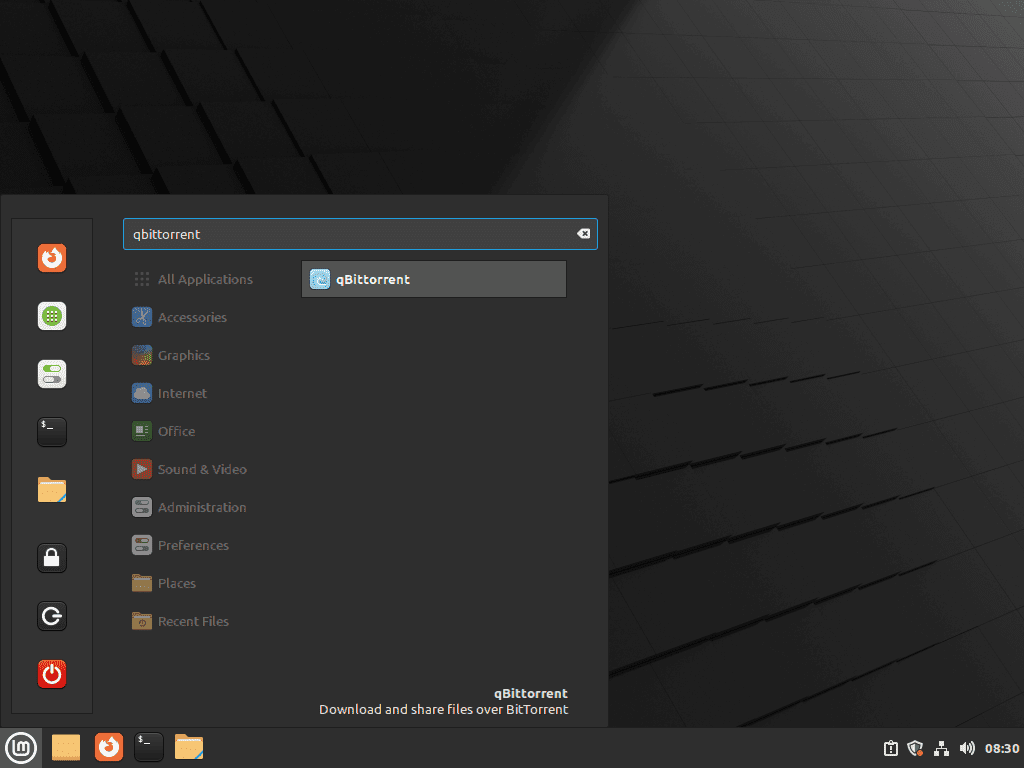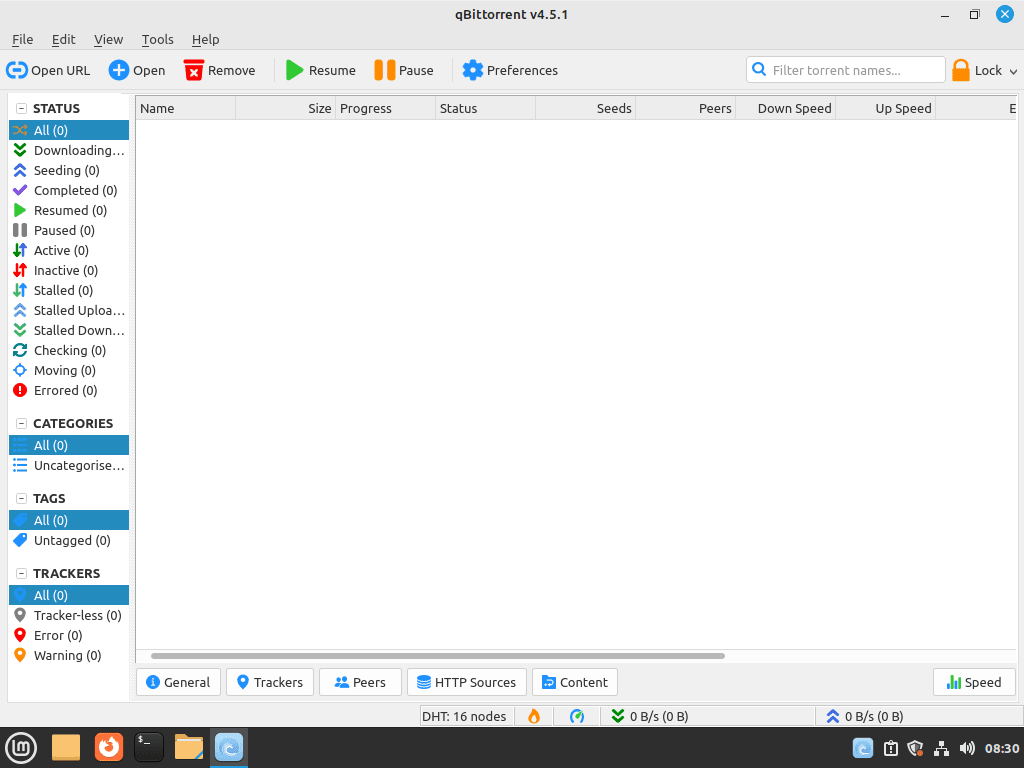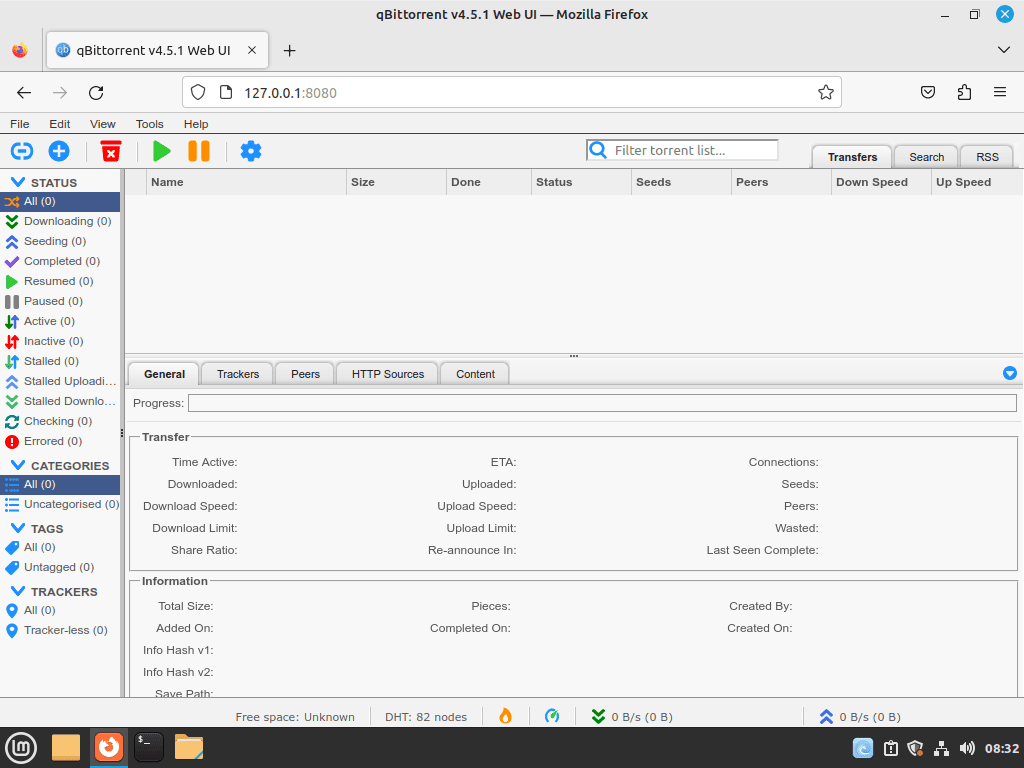qBittorrent is a free, open-source BitTorrent client that combines a lightweight interface with advanced features like integrated search, RSS feed support, sequential downloading, and IP filtering. Unlike proprietary alternatives, it has no subscription fees or tracking. Common use cases include downloading Linux ISOs, subscribing to private tracker RSS feeds that automatically add torrents, and running qBittorrent-nox as a background service for around-the-clock seeding with remote web interface management.
This guide covers installing qBittorrent on Linux Mint using the “qBittorrent Team” Personal Package Archive (PPA, a community-run software repository) for the latest stable or development builds. You’ll install either the desktop client for graphical user interface (GUI) environments or qBittorrent-nox, the background service version controlled through a web interface. The setup includes systemd (Linux Mint’s service manager comparable to Windows Services) configuration, password management, and firewall rules for remote access.
Choose Your qBittorrent Installation Method
Linux Mint users typically choose between stable or unstable PPAs and between the desktop client or the qBittorrent-nox Web UI service. Review the options below so you install the build that matches your needs before adding repositories or services.
| Method | Version/Channel | Stability | Best For |
|---|---|---|---|
| Desktop client via stable PPA | qbittorrent-team/qbittorrent-stable | Fully tested releases with security updates | Daily desktop use and long-term torrent seeding |
| Desktop client via unstable PPA | qbittorrent-team/qbittorrent-unstable | Development snapshots with rapid fixes | Users testing the newest UI features or bug fixes |
| qBittorrent-nox service via stable PPA | qbittorrent-team/qbittorrent-stable | Predictable builds for background services | Multi-device access or always-on seeding |
| qBittorrent-nox service via unstable PPA | qbittorrent-team/qbittorrent-unstable | Unverified builds that may break between updates | Testing new Web UI features before stable release |
Most readers should stick with the stable PPA for both the desktop and qBittorrent-nox service, switching to unstable only when you are troubleshooting a recent bug or evaluating a specific new capability.
Import qBittorrent PPA (Stable or Development Builds)
Update Linux Mint Before qBittorrent Installation
Before proceeding, update your Linux Mint system to ensure all packages are current, which helps avoid conflicts during installation.
Open a terminal window with Ctrl+Alt+T, or search for “Terminal” from the application menu so you can run the following commands.
First, update the package list:
sudo apt updateThen upgrade any outdated packages:
sudo apt upgradeInstall PPA Repository Dependencies
After updating your system, install the necessary dependencies for qBittorrent. These packages enable your Linux Mint system to securely access and import the qBittorrent PPA:
sudo apt install dirmngr ca-certificates software-properties-common apt-transport-httpsThis command will either install the necessary packages or confirm they’re already present on your system.
Import qBittorrent PPA
Next, import the “qBittorrent Team” PPA containing the latest software version. You can choose between the stable PPA and the unstable PPA. The stable PPA contains well-tested versions, while the unstable PPA contains the latest features that may not be thoroughly tested.
However, keep in mind that unstable builds can introduce bugs or breaking changes since they skip the extended testing cycle of stable releases.
Run the following command to import the PPA of your choice:
Option 1: Import qBittorrent stable PPA:
sudo add-apt-repository ppa:qbittorrent-team/qbittorrent-stable -yOption 2: Import qBittorrent unstable PPA:
sudo add-apt-repository ppa:qbittorrent-team/qbittorrent-unstable -yChoose the stable PPA for production environments or systems where reliability matters most. The unstable PPA delivers cutting-edge features and fixes faster but may introduce bugs or breaking changes since builds skip the extended testing cycle. Most users should start with the stable PPA and switch to unstable only when testing specific features or troubleshooting issues.
Update Package Index After PPA Import
After importing the qBittorrent PPA, refresh the package index to include the newly added repository. This ensures your system recognizes the qBittorrent packages during installation. Run the following command:
sudo apt updateInstall qBittorrent Desktop Client
Install the qBittorrent desktop client on your Linux Mint system and prepare to launch it for the first time. If you plan to run only the Web Interface version, skip ahead to the qBittorrent-nox section.
Install qBittorrent Desktop Client
Now that your system has the necessary dependencies and the qBittorrent PPA, install the qBittorrent desktop client with the following command:
sudo apt install qbittorrentVerify the installation by checking the version:
qbittorrent --versionqBittorrent v4.6.7
The version number confirms a successful installation from the PPA.
Launch qBittorrent Desktop Client
With qBittorrent installed, launch and start using the application. To launch the qBittorrent desktop client (either stable or unstable, depending on which PPA you imported), use the following command in your terminal session:
qbittorrentThis command opens the qBittorrent client and allows you to begin managing torrents.
Alternatively, if you prefer to launch qBittorrent using an application icon instead of the terminal, you can access it through your system’s application menu. To do this, follow the path:
Taskbar > Internet > qBittorrent

Upon first launch, qBittorrent displays a legal notice pop-up window. This notice protects qBittorrent from legal liabilities, as torrents play a substantial role in unauthorized downloads today.
After accepting the legal notice, the main qBittorrent window appears and is ready for use.

Install qBittorrent-nox for Remote Web Access
If you prefer managing torrents through a browser rather than a desktop app, qBittorrent-nox provides a web-based alternative. This version runs in the background as a service, letting you add, monitor, and manage torrents from any device on your network—including phones, tablets, or other computers—without keeping the desktop client open.
Install qBittorrent-nox
Install qBittorrent-nox with the following command:
sudo apt install qbittorrent-noxVerify the installation:
qbittorrent-nox --versionqBittorrent v4.6.7
This installs the headless binaries and their templated systemd unit but does not start the daemon automatically. In the next section you will choose which account runs the service and enable it manually before exposing the Web UI at http://localhost:8080. The interface keeps admin as the default username and now generates a temporary password on each launch until you save your own credentials.
Choose the Account that Runs qBittorrent-nox
The package ships a templated systemd unit (qbittorrent-nox@.service) under /usr/lib/systemd/system/ that runs under whatever user name you supply after the @ symbol. Decide whether to run the daemon as your regular login or a dedicated service account so downloaded files stay isolated.
If you prefer a dedicated account, create one with a system user that owns its own home directory:
sudo adduser --system --group --home /var/lib/qbittorrent qbittorrentThe --system flag creates a locked-down user that cannot log in interactively, which keeps the torrent service separate from your daily desktop profile. The explicit --home /var/lib/qbittorrent argument is important: without it, adduser defaults to /nonexistent for system accounts, and the qbittorrent-nox service will fail because it has nowhere to store its configuration. Skip this step entirely if you plan to run the service as your regular username.
Enable the Packaged Systemd Service
With your chosen account ready, enable the built-in systemd service. Beginners can run whoami to confirm their username and then replace your-user manually, while power users can let the shell insert the current username automatically.
Beginner-friendly command (replace the placeholder yourself):
sudo systemctl enable --now qbittorrent-nox@your-userPower-user shortcut (auto-detects your username):
sudo systemctl enable --now qbittorrent-nox@$(whoami)For example, if you created the qbittorrent service user, run:
sudo systemctl enable --now qbittorrent-nox@qbittorrentVerify the daemon is running and review its logs with the standard systemd tools (use either the manual placeholder or the $(whoami) shortcut):
systemctl status qbittorrent-nox@your-user
systemctl status qbittorrent-nox@$(whoami)Expected output when the service is running correctly:
● qbittorrent-nox@username.service - qBittorrent-nox service
Loaded: loaded (/usr/lib/systemd/system/qbittorrent-nox@.service; enabled; preset: enabled)
Active: active (running) since Thu 2025-11-28 10:15:32 UTC; 5s ago
Main PID: 12345 (qbittorrent-nox)
Tasks: 8 (limit: 4567)
Memory: 45.2M
CPU: 892ms
CGroup: /system.slice/system-qbittorrent\x2dnox.slice/qbittorrent-nox@username.service
└─12345 /usr/bin/qbittorrent-nox
The templated unit is maintained by the qBittorrent package itself, so you only need a custom override file if you plan to change advanced options such as ExecStart flags or custom environment variables.
Access qBittorrent Web UI
With the service running, access qBittorrent through your browser’s Web UI. Type the machine’s IP address followed by the port number (8080), for example, 192.168.55.156:8080. If accessing locally, use the localhost address 127.0.0.1:8080.
If accessing the Web UI from a remote machine, ensure your firewall allows traffic on port 8080. Linux Mint users running UFW (Uncomplicated Firewall, a front end to iptables comparable to Windows Firewall) can open the port with the following command:
sudo ufw allow 8080/tcpThe Web UI username defaults to admin, but qBittorrent 4.6.1 and newer no longer ship with a fixed password.
Upstream developers removed the legacy admin/adminadmin WebUI credentials starting with qBittorrent 4.6.1. The daemon now generates a random temporary password each time it starts without saved credentials and prints it to stdout once. See the upstream issue #19984, which also documents why you must read this message from the systemd journal in headless deployments.
Check the qBittorrent service logs to capture the temporary password before your first login. Choose whichever command style matches your comfort level:
Beginner-friendly command (replace the placeholder manually):
sudo journalctl -u qbittorrent-nox@your-user -n 50 | grep -i "temporary password"Power-user shortcut (auto-fills your username with $(whoami)):
sudo journalctl -u qbittorrent-nox@$(whoami) -n 50 | grep -i "temporary password"If you don’t see the line, restart the service while following the log stream so you can copy the password immediately. Again, use whichever variant you prefer:
Beginner-friendly restart and tail:
sudo systemctl restart qbittorrent-nox@your-user
sudo journalctl -fu qbittorrent-nox@your-userPower-user restart and tail:
sudo systemctl restart qbittorrent-nox@$(whoami)
sudo journalctl -fu qbittorrent-nox@$(whoami)Expect output similar to the following:
******** Information ******** The WebUI administrator username is: admin The WebUI administrator password was not set. A temporary password is provided for this session: VBGK9pUeT You should set your own password in program preferences.
Sign in with username admin and the temporary password that appears in your log. Each restart generates a new temporary password until you store permanent credentials.
Immediately set your own username and password from the Web UI by opening the gear icon (Options) and navigating to Web UI > Authentication.

After saving the change, restart the daemon so the hashed credentials reload cleanly. Use the same command style you chose earlier:
Beginner-friendly restart:
sudo systemctl restart qbittorrent-nox@your-userPower-user restart:
sudo systemctl restart qbittorrent-nox@$(whoami)Reopen the Web UI and confirm the new username/password combination works before disabling your log tail session.
Managing qBittorrent: Updates and Removal
Update qBittorrent or qBittorrent-nox
The PPA automatically provides updates through Linux Mint’s standard package management. To check for and install qBittorrent updates, run the following command:
sudo apt updateIf an update is available, install it with:
sudo apt upgradeRemove qBittorrent or qBittorrent-nox
To uninstall qBittorrent completely, first remove the PPA you imported earlier. If you need a refresher on purging repositories, the remove a PPA on Ubuntu guide walks through every cleanup method (the process is identical on Linux Mint).
Remove the PPA with the appropriate command:
Remove qBittorrent stable PPA:
sudo add-apt-repository --remove ppa:qbittorrent-team/qbittorrent-stable -yRemove qBittorrent unstable PPA:
sudo add-apt-repository --remove ppa:qbittorrent-team/qbittorrent-unstable -yAfter removing the PPA, uninstall qBittorrent:
sudo apt remove qbittorrentAlternatively, for qBittorrent-nox installations:
sudo apt remove qbittorrent-noxRemove User Configuration Data
The uninstall commands remove the application but leave your configuration, download history, and torrent data intact. To completely remove all qBittorrent user data, delete the configuration directories:
The following commands permanently delete your qBittorrent settings, RSS feeds, torrent history, and saved credentials. Export any important data (such as RSS feed URLs or IP filter lists) before proceeding.
rm -rf ~/.config/qBittorrent ~/.local/share/qBittorrent ~/.cache/qBittorrentIf you created a dedicated qbittorrent system user for the nox service, remove its data directory as well:
sudo rm -rf /var/lib/qbittorrentTroubleshoot qBittorrent Issues
ittorrent IssuesService Fails to Start
If the qBittorrent-nox service fails to start, check the journal for error details:
sudo journalctl -xeu qbittorrent-nox@$(whoami)A common error occurs when the service account has no valid home directory:
qbittorrent-nox: Could not create required directory: /nonexistent/.config/qBittorrent
This happens when a system user was created without specifying a home directory. Fix it by recreating the user with a proper home path:
sudo userdel qbittorrent
sudo adduser --system --group --home /var/lib/qbittorrent qbittorrentThen restart the service and verify it is running:
sudo systemctl restart qbittorrent-nox@qbittorrent
systemctl status qbittorrent-nox@qbittorrentPort 8080 Already in Use
If another application occupies port 8080, the Web UI will not be accessible. Identify the conflicting process:
sudo lsof -i :8080Example output showing a conflict:
COMMAND PID USER FD TYPE DEVICE SIZE/OFF NODE NAME java 1234 user 12u IPv4 56789 0t0 TCP *:8080 (LISTEN)
Stop the conflicting service or change the qBittorrent Web UI port. To change the port, edit the configuration file before starting the service:
nano ~/.config/qBittorrent/qBittorrent.confAdd or modify the WebUI\Port setting under [Preferences]:
[Preferences] WebUI\Port=9090
Restart the service and update your firewall rule accordingly.
Temporary Password Not Appearing in Logs
The temporary password prints only once when the service starts without saved credentials. If you missed it, restart the service while following the log stream:
sudo systemctl restart qbittorrent-nox@$(whoami) && sudo journalctl -fu qbittorrent-nox@$(whoami)Watch for the password line, then press Ctrl+C to exit the log stream after copying it.
Conclusion
You now have qBittorrent installed via the official PPA with either the desktop client or qBittorrent-nox for headless operation. The key techniques covered include configuring the templated systemd service under a dedicated user account, retrieving the temporary WebUI password from journalctl, and setting permanent credentials through the Web UI authentication settings. For ongoing maintenance, standard APT upgrades keep qBittorrent current, and the removal commands clean up both the package and PPA when needed.
Essential qBittorrent Resources
Here are some useful links related to using qBittorrent:
- qBittorrent Official Website: Visit the official qBittorrent website for information about the application, its features, and download options.
- qBittorrent GitHub Repository: Access the qBittorrent GitHub repository to view the source code, report issues, and contribute to the development.
- qBittorrent Wiki: Explore the qBittorrent wiki for detailed documentation, tutorials, and guides on using qBittorrent.
- qBittorrent Forum: Join the qBittorrent forum to discuss issues, share solutions, and get support from the community.


I have been struggling for over a week, trying to install it from the appimage without success!
I sailed through this in just a few minutes. Really excellent and clear, I couldn’t possibly go wrong!
This is a model of how it should be done.
Thank you so much.
Thank you for the feedback.
Thank Im just getting starting with Linux. This has been a great help thank you.
Hi Robert, appreciate the feedback.